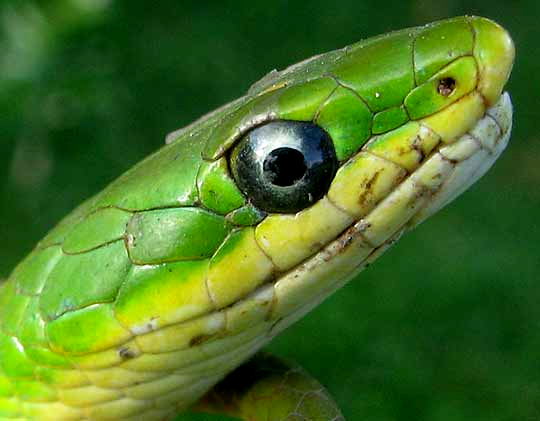Excerpts from Jim Conrad's
Naturalist Newsletter

from the May 19, 2013 Newsletter issued from the Frio Canyon Nature Education Center in northern Uvalde County, southwestern Texas, on the southern border of the Edwards Plateau; elevation ~1750m (~5750 ft); N29.62°, W99.86°; USA
GREEN SNAKE
When the neighbor's two boys on their oversized four-wheeler roared up to my backdoor carrying a gallon jar stuffed with grass I figured they'd caught another critter, and I was right. This time it was the green snake shown above.
The boys said the snake hadn't been stomped, beaten or run over, but it bore some bumps and kinks and moved awfully slowly to be a healthy snake, so I felt sorry for it from the beginning. Below you can see a close-up of the head, looking like it's been mashed into the ground sometime:

I took the head picture because more than one species of green snake exists, and often it's the configuration of scales on the head that enable you to distinguish otherwise look-alike species. However, in this case the scales weren't needed, since there's only one green snake in southwestern Texas, the Rough Green Snake, OPHEODRYS AESTIVUS, distributed throughout the entire Southeastern US, as far north as southern New Jersey and eastern Kansas, and south into eastern Mexico. The Eastern and Western Smooth Green Snake species with which our snake might be confused occur much farther to the north, mostly in the northeastern US and adjacent Canada.
Rough Green Snakes are graceful, mild-tempered tree-dwellers that during the day move slowly through vegetation, often trees and bushes, searching for grasshoppers, crickets, caterpillars and spiders. You couldn't want a more peaceful and agreeable snake, but when I was a kid on the Kentucky farm we figured that any reptile that was green had to be poisonous and they didn't last long around our house. When green snakes die they turn blue or black, and in our mind that surprising metamorphosis only confirmed the diabolical nature of the peaceful little being.
In a 1923 issue of Journal of American Folklore, Frank Speck writes that certain indigenous Americans in the northern regions believed that gently biting along the body of a green snake would cure a toothache.